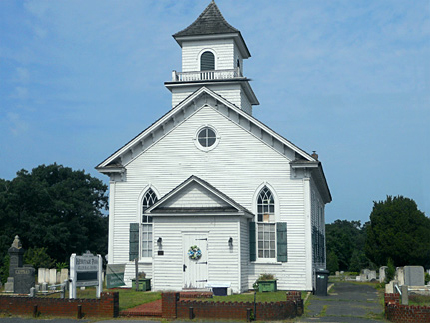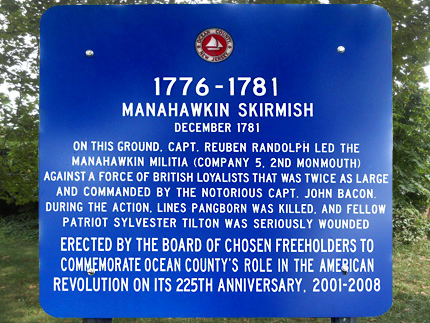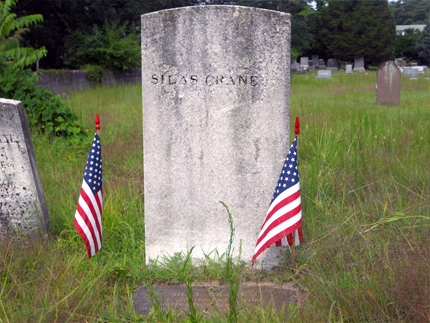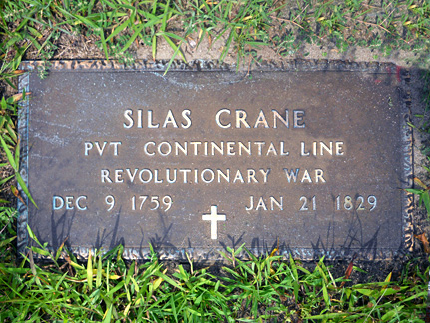



Old Manahawkin Baptist Church & Cemetery
Site of the Manahawkin Skirmish
Rte. 9 and North Lakeshore Dr.
Map / Directions to Manahawkin Skirmish Site
Now the home of the
Stafford Township Historical Society Heritage Cultural Center
Background
The last large-scale battle of the Revolutionary War took place at Yorktown, Virginia, and ended on October 19, 1781. The surrender of British General, Charles Cornwallis, at Yorktown brought about the decisive blow to the British army. However, the war did not officially end for another two years. For the most part, major fighting between the American and British armies was stopped during this period, as both sides waited for treaty negotiations to officially end the war.
However, for the citizens of New Jersey, the violence and bloodshed unfortunately continued during this period. Rather than fighting between large armies, there was mainly fighting between local residents and militia who supported American independence, and those who remained Loyal to Britain. Monmouth County was a particular hotspot for this form of partisan fighting. [1] Manahawkin, which is now part of Ocean County, was then part of Monmouth County, because Ocean County was not formed until 1850 from a portion of Monmouth County. [2]
Some of the Loyalist attacks in this area were conducted by men known as Pine Robbers. The name derived from the fact that they tended to operate and hide out in the large wilderness section of South Jersey known as the Pine Barrens. One of the most infamous of the Pine Robbers was Captain John Bacon. Bacon's exploits in Monmouth County during this period continued right up until almost the end of the war. At the very end of 1781, two months after Yorktown, Bacon and a band of Loyalists came through Manahawkin on one of their raiding missions, resulting in a skirmish in the land around the Manahawkin Baptist Church.
Manahawkin Skirmish
December 30-31, 1781
[3]
On December 30, 1781, word reached Manahawkin that Bacon and a band of raiders were moving through the area plundering, and would likely come through Manahawkin. Local militia assembled quickly at the tavern of militia captain Reuben Fitz Randolph, which was located about 200 yards south of the Baptist Church. They prepared to resist Bacon and his men if and when they came through Manahawkin.
As the night grew late and Bacon's men did not appear, it seemed that the news of their approach may have been a false alarm. The militiamen went to sleep around two or three o'clock in the morning, but posted sentinels to keep watch during the night. Two sentinels were posted near the Baptist Church, and two closer to Randolph's tavern.
Just before daylight on the morning of December 31, Bacon's men came marching in from the north, from Barnegat Township. When the sentinels near the Baptist Church heard Bacon's raiders approaching, they ran to the tavern to sound the alarm to alert their fellow militiamen.
Before the militiamen could properly organize, Bacon's men opened fire on them, killing one - Lines Pangborn, and wounding another - Sylvester Tilton. There were about thirty or forty in Bacon's raiding party, which was twice the militia's strength. The outnumbered militiamen were forced to retreat. Bacon's men continued on through Manahawkin, heading south towards West Creek.
Bacon would continue to raid and plunder in this area over the following year and a quarter. Ten months after the Manahawkin skirmish, Bacon was involved in what is known as the Long Beach Island Massacre. See the Long Beach Island page for the story.
The Church and Cemetery
The original church structure which stood here at the time of the Revolutionary War was built circa 1758. It was rebuilt in 1867 on the original foundation. Some of the original church structure exists within the building. [4] It is now the home of the Stafford Township Historical Society Heritage Cultural Center
The cemetery next to the church contains the grave of Revolutionary War soldier Private Silas Crane, who served in the militia as well as the Continental Army. [5]



1. ^ For those interested in a book which focuses on the partisan fighting in Monmouth County during the Revolutionary War, see:
Michael S. Adelberg, The American Revolution in Monmouth County - The Theatre of Spoil and Destruction (Charleston; The History Press, 2010)
2. ^ Regarding Ocean County formed from Monmouth County in 1850, see:
John F. Snyder, The Story of New Jersey's Civil Boundaries: 1606-1968 (Trenton: Bureau of Geology and Topography, 1969) page 201
Available as a PDF on the State of New Jersey website here. (Note that although the information is on the page numbered 201 of the document, it is on page 191 of the PDF file.)Journal of the Sixth Senate of the State of New Jersey: Being the Seventy-Fourth Session of the Legislature (Somerville, N.J.: Allan N. Wilson, 1850) Pages 161-163, 170, 178-180, 185-186, 194, 206, 209, 212, 215, 217, 219-220, 243, and 277
Available to be read at Google Books here3. ^ As with many incidents involving Bacon, the documentation for the Manahawkin Skirmish is sketchy. The account of the Manahawkin Skirmish in this entry is based on the writings of Edwin Salter in the late 1800's.
Salter wrote about the event in at least three different versions, which differ in wording and in the details included. However, the details in each version do not contradict each other. These versions are listed below in chronological order:
Edwin Salter, Centennial History of Ocean County (Toms River: 1878) Pages 24-25
Available to be read at the Internet Archive hereEdwin Salter, George C. Beekman, Old Times in Old Monmouth - Historical Reminiscences of Old Monmouth County, New Jersey (Freehold, New Jersey: 1887) Pages 44-45
Available to be read at the Internet Archive hereEdwin Salter, A History of Monmouth and Ocean Counties (Bayonne: E. Gardner & Son, Publishers, 1890) Pages 174-176 AND told in slightly different wording on Pages 316-318
Available to be read at the Internet Archive here
▸ This book actually describes the Manahawkin Skirmish in two different accounts in the same book. The account which appears on page 316-318 is actually an exact reprinting of the one from Centennial History of Ocean County, although it is not specified as such. The account on pages 174-176 is a similar account with different wording.It appears that Salter is the main basis for the accounts of the Manahawkin Skirmish written since his books were published. All of the modern books and articles about the Manahawkin Skirmish that I found either credited Salter as their source or, if they did not specify a source, their wording indicated that their information was based on Salter.
It should be noted that Salter was writing a century after the Manahawkin Skirmish, and that he does not specify his sources. His account is likely based largely on local lore (with one notable exception, described after the bullet point below). This does not mean that his story is not correct, but only that these factors should be considered when assessing its reliability.
• One original source which Salter mentions and partially quotes (in A History of Monmouth and Ocean Counties pages 317-318) is the
American Revolution Pension Request of Ann Pangborn, the widow of Lines (or Linus) Pangborn.
The full text of the pension request can be found on pages 48-53 of a PDF available on the Monmouth County website here
The Pension Request contains testimony stating several facts which are in agreement with Salter's accounts:
~ Lines Pangborn served in the militia,
~ He was killed by Refugees (Loyalists) on December 31, 1781 at Manahawkin
~ Sylvester Tilton was wounded as the same incident. These facts areOn one point, the testimony contradicts Salter's accounts.
Salter states that Reuben Randolph was in command of the militiamen.
However, two pieces of testimony in the Pension Request clearly refer to the commander of this militia as Captain Joseph Randolph. It describes Reuben Randolph as being part of the militia at the Manahawkin Skirmish, but not in command. In fact, it states that Reuben Randolph's own testimony names Joseph Randolph as the Commander.
4. ^ National Register of Historic Places / Inventory - Nomination Form for the Manahawkin Baptist Church
Available as a PDF on the National Park Service website here5. ^ The Daughters of the American Revolution Genealogical Research System, where Silas Crane is Ancestor # A027475
William S. Stryker, Official Register of the Officers and Men of New Jersey in the Revolutionary War (Trenton: Wm. T. Nicholson & Co., 1872) pages 175 and 562
Available to be read at Google Books here